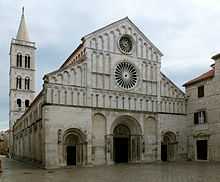Zadar Cathedral

The Cathedral of St. Anastasia (Croatian: Katedrala sv. Stošije) is a Roman Catholic cathedral in Zadar, Croatia. It is the seat of the Archdiocese of Zadar, and the largest church in all of Dalmatia (the coastal region of Croatia).
The church's origins date back to a Christian basilica built in the 4th and 5th centuries, while much of the currently standing three-nave building was constructed in the Romanesque style during the 12th and 13th centuries. The site has been submitted to UNESCO's Tentative List of World Heritage Sites.[1]
History
The first known bishop in Zadar was Felix - he attended two church councils, the first in Aquileia in 381 and the second in Milan in 390. The basilica's original patron was St. Peter. During the time of bishop Donatus, the diocese received the ashes of St. Anastasia of Syrmia from Emperor Nikephoros I, whom the cathedral took as patron. Donatus commissioned a sarcophagus for the remains, which are still held in the cathedral.
During the siege of Zadar by the Venetians and Crusaders in 1202, the cathedral was heavily damaged. For the entire 13th century the building was under repair. It was reconsecrated on 27 May 1285.[2]
Over the cathedral's history, two popes have made personal visits. Pope Alexander III arrived in 1177 and visited the cathedral as well as St. Anastasia's sarcophagus. Pope John Paul II came to the cathedral on June 9, 2003 on one of his last international visits.
See also
- Tentative list of World Heritage Sites in Croatia
References
- ↑ Zadar - Episcopal complex
- ↑ "Sv. Stošija (Katedrala)" (in Croatian). Retrieved 23 December 2014.
Coordinates: 44°6′58.5″N 15°13′28″E / 44.116250°N 15.22444°E
| ||||||||||||||||||||||
| ||||||||||||||||||||||||
